I’ll show you mine…
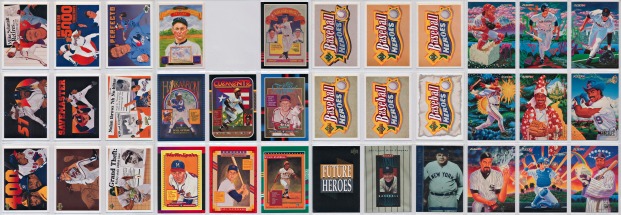
If you’re like me, you have more cards in boxes than you know what to do with. Small boxes, large boxes, multi-row boxes, toploader boxes… For most cards, their final resting place (before the inevitable trash can or recycle bin of fate) will be a cardboard box, never to be seen by human eyes ever again. It’s an efficient method of card storage, but efficiency often comes at the price of emotional connections. Sometimes, we want to keep cards viewable, even if we are the only ones who ever view them. And for that, we have binders.
Binders can hold a great number of different things. You name it and there’s a pocketed binder page made for it. Comic books, coins, postcards – if it’s flat, it fits in something. Nothing though, aside from a single sheet of paper, fits better than the 9-pocket sports card page. There’s just something about pages of plastic-encased cardboard that just feels right. Some people put every card in pages. Others limit the honor to a select few. In any case, I have just one question: what’s in your binder?
I was one of those kids who went around to card shows lugging around a big binder. Lists of cards I needed to complete sets were tucked away in the back, but the bulk of the space was taken up by every Ken Griffey Jr. card I had. It was an easy way to avoid purchasing duplicate cards amid the exponential increase in the number of sets, subsets, inserts, and parallels of the early ’90s. No matter how many cards I got though, I never came close to having all of them. And so that project was shut down at the end of the decade for being impractical. Along the way though, I added a few interesting odds and ends to the binder.
Upper Deck Art Cards
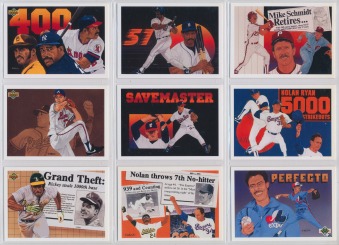 One of the things that set Upper Deck apart in their early years was the use of art cards to celebrate significant accomplishments. These weren’t part of a regular subset like Donruss’s Diamond Kings, they were just random base cards with cool artwork. These days, something like this would be saved for inserts or short printed variations. Upper Deck had those, too (starting with Michael Jordan in 1991 and including one of the cards shown here), but these are some of the overlooked gems of the 1989-1992 sets. There may be more than these 9, but 9 is the right number to fit in a page and that’s good enough for me.
One of the things that set Upper Deck apart in their early years was the use of art cards to celebrate significant accomplishments. These weren’t part of a regular subset like Donruss’s Diamond Kings, they were just random base cards with cool artwork. These days, something like this would be saved for inserts or short printed variations. Upper Deck had those, too (starting with Michael Jordan in 1991 and including one of the cards shown here), but these are some of the overlooked gems of the 1989-1992 sets. There may be more than these 9, but 9 is the right number to fit in a page and that’s good enough for me.
Donruss Hall of Fame Diamond Kings
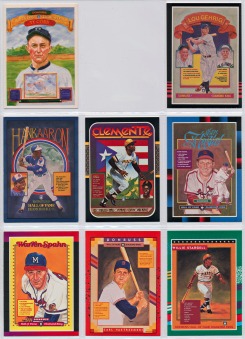 You can’t have a collection of art cards without some Diamond Kings, but all of them would be a bit much. 26 cards (one for each team) and a checklist makes each set fit in exactly three binder pages, but a decade’s worth is just too much to chase down for a project like this. So I went with the Hall of Fame Diamond Kings instead. Each card shows the artwork by Dick Perez that was used for the puzzle inserted into that year’s packs of Donruss, with the appropriate border for that year’s base set (since these are ordinary base cards). Interestingly, while Donruss featured puzzle pieces from 1982 to 1992, only 8 of the puzzles have a card in the base set. Babe Ruth (1982), Ted Williams (1984), and Rod Carew (1992) were omitted. It helps them to all fit in one page, at least.
You can’t have a collection of art cards without some Diamond Kings, but all of them would be a bit much. 26 cards (one for each team) and a checklist makes each set fit in exactly three binder pages, but a decade’s worth is just too much to chase down for a project like this. So I went with the Hall of Fame Diamond Kings instead. Each card shows the artwork by Dick Perez that was used for the puzzle inserted into that year’s packs of Donruss, with the appropriate border for that year’s base set (since these are ordinary base cards). Interestingly, while Donruss featured puzzle pieces from 1982 to 1992, only 8 of the puzzles have a card in the base set. Babe Ruth (1982), Ted Williams (1984), and Rod Carew (1992) were omitted. It helps them to all fit in one page, at least.
Upper Deck Baseball Heroes
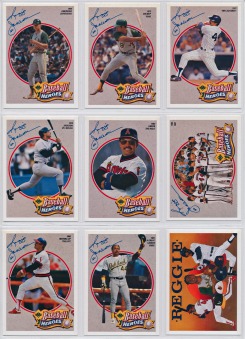 There was a lot to like about the early Upper Deck products and this might have been my favorite. The first Baseball Heroes set, released in 1990 Upper Deck High Number Series, was also the first successful insert set. Inserts appeared sporadically in the ’80s, but most were thought of as little more than oddball cards. The Reggie Jackson Baseball Heroes set changed that and ushered in the great and terrible age of inserts. Regardless of what was to come, this 10-card set stands well on its own. The set starts with an unnumbered header card with the Baseball Heroes logo, covers Jackson’s career in 8 cards, and then wraps things up with an art card checklist. Autographed versions of the art card were also randomly inserted. The 9 numbered cards fit well enough in a page, but what to do with the header card?
There was a lot to like about the early Upper Deck products and this might have been my favorite. The first Baseball Heroes set, released in 1990 Upper Deck High Number Series, was also the first successful insert set. Inserts appeared sporadically in the ’80s, but most were thought of as little more than oddball cards. The Reggie Jackson Baseball Heroes set changed that and ushered in the great and terrible age of inserts. Regardless of what was to come, this 10-card set stands well on its own. The set starts with an unnumbered header card with the Baseball Heroes logo, covers Jackson’s career in 8 cards, and then wraps things up with an art card checklist. Autographed versions of the art card were also randomly inserted. The 9 numbered cards fit well enough in a page, but what to do with the header card?
 That problem solved itself over the next few years. Nolan Ryan, Hank Aaron, Ted WIlliams, Johnny Bench/Joe Morgan, and Willie Mays all followed Jackson with their own Baseball Heroes sets that kept the same format and continued the numbering. These weren’t six different sets, they were all part of a single set running across multiple years. But how long could Upper Deck keep it going?
That problem solved itself over the next few years. Nolan Ryan, Hank Aaron, Ted WIlliams, Johnny Bench/Joe Morgan, and Willie Mays all followed Jackson with their own Baseball Heroes sets that kept the same format and continued the numbering. These weren’t six different sets, they were all part of a single set running across multiple years. But how long could Upper Deck keep it going?
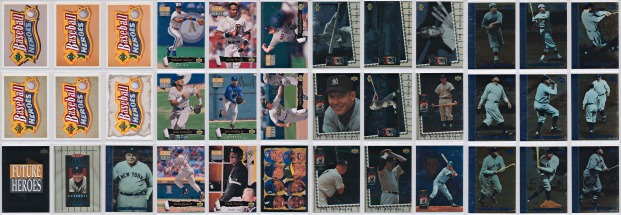 Not much longer, as it turns out. 1993 Upper Deck Series 2 changed the focus to Future Heroes, showcasing some of the game’s best young talent. More than 20 years later, they are long since retired and have all appeared on Hall of Fame ballots. Some made it in, some will be inducted this year, some languish on the ballot, and some have fallen off the ballot with little fanfare. Most have been caught up in accusations or speculation of PED use during their careers (though all should be suspect based on how flimsy the cases against some are). Still, it’s hard to argue that Upper Deck didn’t get this list right. They just should have called it Future Heroes and Villains.
Not much longer, as it turns out. 1993 Upper Deck Series 2 changed the focus to Future Heroes, showcasing some of the game’s best young talent. More than 20 years later, they are long since retired and have all appeared on Hall of Fame ballots. Some made it in, some will be inducted this year, some languish on the ballot, and some have fallen off the ballot with little fanfare. Most have been caught up in accusations or speculation of PED use during their careers (though all should be suspect based on how flimsy the cases against some are). Still, it’s hard to argue that Upper Deck didn’t get this list right. They just should have called it Future Heroes and Villains.
Base Upper Deck made a premium jump in 1994 and so did the Baseball Heroes inserts. Now just one 10-card set per year, these new Baseball Heroes cards got the premium treatment (shiny!) and went back to focusing on one all-time great. UD brought out the big guns for these, going with Mickey Mantle in 1994 and Babe Ruth in 1995 (the Ruth set was the first without an art card checklist). That brought the checklist up to 81 numbered cards and 9 unnumbered headers, perfect for 10 binder pages. That would have been a good time to call it quits.
But they didn’t; that’s just where my binder ends. After spending 6 years in base Upper Deck, the Baseball Heroes insert set jumped to the super premium SP in 1996. Once again, they featured active players instead of retired greats, with an unnumbered Ken Griffey Jr. header card in addition to 9 numbered cards (including Ken Griffey Jr.). In 1997, the set made its final appearance, now with just 10 numbered Ken Griffey Jr. cards to bring the numbered cards up to 100. And with that, the now 110-card set (1-100 plus 10 headers) was complete. Stashed away in a box somewhere.
The Baseball Heroes name and logo would make a return as an insert set and a product, but neither had the appeal of the original. For all UD’s attempts to drive the set in the premium direction, it’s the simpler earlier years that are still remembered.
Fleer Pro-Visions
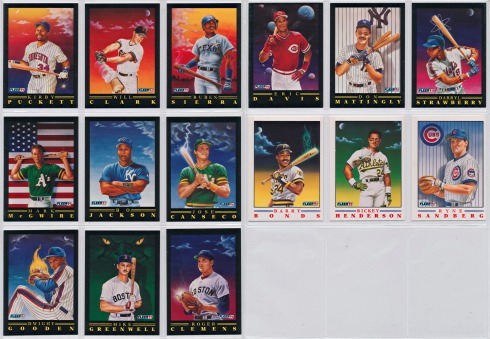 Proving that even a stopped clock is right twice a day, Fleer managed to introduce two hot insert sets in the early ’90s. While the Rookie Sensations inserts in magazine stand packs of 1992 Fleer became inexplicably popular before crashing, the popularity of Pro-Visions was at least understandable and reasonable. Each card featured artwork of a star player that focused on some sort of saying or nickname related to that player. The original 12-card Pro-Visions insert set may have been the only reason anyone bought packs of garish yellow 1991 Fleer cards. And then the factory set had four more, just to make you buy everything twice. Still need to chase down that last one…
Proving that even a stopped clock is right twice a day, Fleer managed to introduce two hot insert sets in the early ’90s. While the Rookie Sensations inserts in magazine stand packs of 1992 Fleer became inexplicably popular before crashing, the popularity of Pro-Visions was at least understandable and reasonable. Each card featured artwork of a star player that focused on some sort of saying or nickname related to that player. The original 12-card Pro-Visions insert set may have been the only reason anyone bought packs of garish yellow 1991 Fleer cards. And then the factory set had four more, just to make you buy everything twice. Still need to chase down that last one…
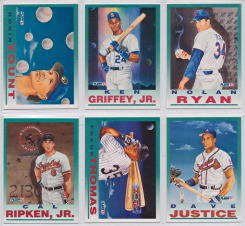 So, of course, once Fleer established a popular insert set in 1991, they made it a dull subset in 1992. Relegated to just a 6-card subset within the base 1992 set (and stuck with 1992’s theme instead of carrying over a version of the 1991 Pro-Visions style), the 1992 Pro-Visions set got everything wrong. And it did it with some of the biggest stars to be featured in the set’s 5-year run. Even the artwork missed the mark; Frank Thomas looks like he got one of his bats from an irate Warner Brothers cartoon character, Ken Griffey Jr. is portrayed as a crusader for LGBT inclusiveness with a failed Star Trek reference, Nolan Ryan is counting the days he’s been locked up in baseball prison, and Robin Yount is clearly tripping (base)balls.
So, of course, once Fleer established a popular insert set in 1991, they made it a dull subset in 1992. Relegated to just a 6-card subset within the base 1992 set (and stuck with 1992’s theme instead of carrying over a version of the 1991 Pro-Visions style), the 1992 Pro-Visions set got everything wrong. And it did it with some of the biggest stars to be featured in the set’s 5-year run. Even the artwork missed the mark; Frank Thomas looks like he got one of his bats from an irate Warner Brothers cartoon character, Ken Griffey Jr. is portrayed as a crusader for LGBT inclusiveness with a failed Star Trek reference, Nolan Ryan is counting the days he’s been locked up in baseball prison, and Robin Yount is clearly tripping (base)balls.
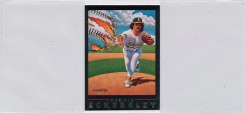 I don’t know what happened in 1993. I bought boxes of 1993 Fleer Series 1 and Series 2 specifically to get the 1993 Pro-Visions, only to find out that they weren’t in the type of boxes I bought. I did get a complete base set though, for whatever that’s worth (not much). These are tough to track down on the secondary market.
I don’t know what happened in 1993. I bought boxes of 1993 Fleer Series 1 and Series 2 specifically to get the 1993 Pro-Visions, only to find out that they weren’t in the type of boxes I bought. I did get a complete base set though, for whatever that’s worth (not much). These are tough to track down on the secondary market.
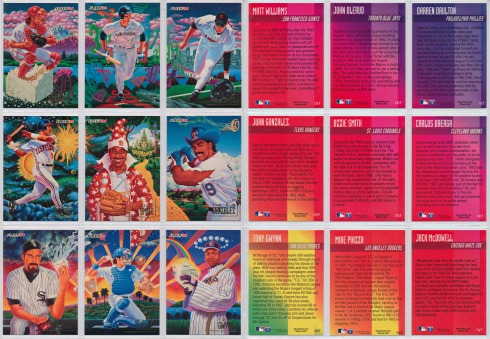 And then, this. Did Fleer actually figure out how to make this concept work? It’s a miracle! The 1994 Pro-Visions set was clearly made to be displayed in a binder page. The 9-card set forms a single image when placed in a 3×3 layout. Things don’t quite line up from one card to the next and the cards don’t account for the gaps between pockets, but there’s enough to make it work. The back features a diagonal color gradient that reinforces the concept (and seems to account for the gaps). Every binder should have this set.
And then, this. Did Fleer actually figure out how to make this concept work? It’s a miracle! The 1994 Pro-Visions set was clearly made to be displayed in a binder page. The 9-card set forms a single image when placed in a 3×3 layout. Things don’t quite line up from one card to the next and the cards don’t account for the gaps between pockets, but there’s enough to make it work. The back features a diagonal color gradient that reinforces the concept (and seems to account for the gaps). Every binder should have this set.
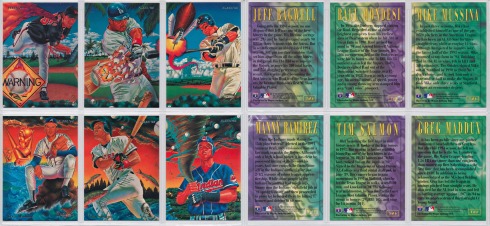 1995 Fleer: “Hey, at least we tried.” It’s the same concept as the 1994 set, only with 6 cards instead of 9. Considering that the base set uses four completely different nonsensical designs, you would think that they could have put together three more Pro-Visions concepts. But I guess they only had the budget to do three more Pro-Visions or three more confusing ways to put stats on the front of a card for no apparent reason and went with the latter. The back though earns Fleer an ‘F’ for effort.
1995 Fleer: “Hey, at least we tried.” It’s the same concept as the 1994 set, only with 6 cards instead of 9. Considering that the base set uses four completely different nonsensical designs, you would think that they could have put together three more Pro-Visions concepts. But I guess they only had the budget to do three more Pro-Visions or three more confusing ways to put stats on the front of a card for no apparent reason and went with the latter. The back though earns Fleer an ‘F’ for effort.
Topps Retired Player Base Cards
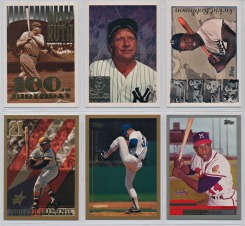 And just to make sure Topps wasn’t left out, I gathered up some of their base cards featuring retired players, usually that year’s reprint subject. The concept ran from 1995 to 2000 and featured some all-time greats. Since then though, only Mickey Mantle as card number 7 (2006-2012) has been featured as a non-SP retired player in base Topps.
And just to make sure Topps wasn’t left out, I gathered up some of their base cards featuring retired players, usually that year’s reprint subject. The concept ran from 1995 to 2000 and featured some all-time greats. Since then though, only Mickey Mantle as card number 7 (2006-2012) has been featured as a non-SP retired player in base Topps.
So there you have it, the back half of my “Ken Griffey Jr. and the ’90s” binder. Like any proper collection, it’s somewhat random and not quite complete, but still interesting in its own way. I showed you mine, so let’s see yours. What’s in your binder?
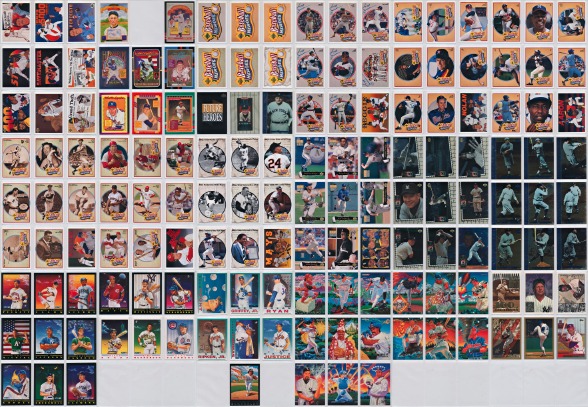
Comments are closed.